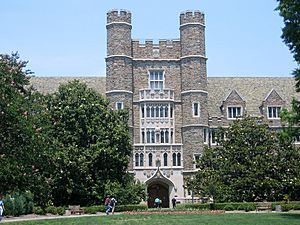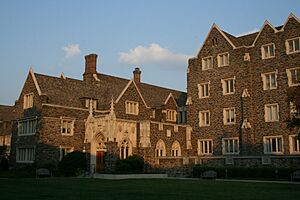Duke University School of Medicine facts for kids
 |
|
| Type | Private medical school |
|---|---|
| Established | 1925 |
| Founder | James B. Duke |
|
Parent institution
|
Duke University |
| Dean | Mary E. Klotman |
|
Academic staff
|
2,200+ |
| Students | 450 |
| Location |
,
,
United States
36°00′03″N 78°56′25″W / 36.0007°N 78.9403°W |
| Campus | Urban |
| Colors | Blue and white |
| Website | https://medschool.duke.edu |
The Duke University School of Medicine, often called Duke Med, is the medical school of Duke University. It was started in 1925 by James B. Duke. A medical school is where students go to learn how to become doctors.
Duke Med is part of the Duke University Health System. This system includes the Duke University School of Nursing, Duke University Hospital, and other hospitals and clinics. Together, they help train future doctors and provide health care. Medical students get to practice what they learn in these hospitals and clinics.
Contents
History of Duke Med
The idea for a medical school here began a long time ago, in 1891. John Franklin Crowell, who was the president of Trinity College (which later became Duke University), first talked about creating a medical school.
In 1924, James B. Duke created the Duke Endowment. He gave $40 million to Trinity College, which then became Duke University. The next year, he asked for a medical school, a nursing school, and a hospital to be built. His goal was to make health care better in the Carolinas and across the country.
In 1929, the new medical school opened. Three thousand people wanted to join, but only 70 students were chosen. This first group included four women. Just four years later, Duke was already one of the top 20 medical schools in the United States!
Important Discoveries and Care at Duke Med
Over the years, Duke Med has made many important contributions to medicine. Here are some key moments:
- 1937—Doctors started the first program in the country to study brain tumors.
- 1968—Robert Lefkowitz discovered how adrenaline affects the body.
- 1972—New laws were made for child safety caps on medicine bottles. This happened because of work by Jay Arena.
- 1982—Rebecca Buckley helped children with "bubble boy disease" (a very weak immune system). She used bone marrow transplants to make them healthy.
- 1984—Scientists helped find the virus that causes HIV.
- 1990—The Duke Pediatric Blood and Marrow Transplant Program was started.
- 1994—Doctors found a way to cure babies born without an immune system using thymus transplantation.
- 1995—Duke scientists found a link between certain genes (BRCA1 and BRCA2) and breast and ovarian cancers.
- 2001—Miguel Nicolelis created a system that let monkeys control robot arms with their thoughts. This was a big step for helping paralyzed people.
- 2006—A new treatment for Pompe’s disease was developed.
- 2011—Scientists found gene changes that play a big role in common brain tumors and other cancers.
- 2013—A bioengineered blood vessel was created and used in a patient for the first time in the U.S.
- 2015—A modified polio virus was used in trials to fight brain tumors.
- 2019—Many Duke faculty members were named among the most cited researchers in the world. This showed Duke Med was one of the top institutions for research.
How Good is Duke Med?
Duke University School of Medicine is known as one of the best medical schools. U.S. News & World Report ranked it #3 in the country for research in 2022. Many of its programs are also top-ranked:
- Surgery: #2
- Anesthesia: #4
- Internal Medicine: #5
- Radiology: #6
- Pediatrics: #7
- Obstetrics/Gynecology: #8
- Psychiatry: #10
Getting into Duke Med
It is very hard to get into Duke Med's doctor program. More than 7,500 people apply each year, but only about 115 are accepted. The school is also known for having a diverse group of students.
One special thing about Duke's program is its unique curriculum. Students get to work with patients a year earlier than at most other medical schools. They also spend a whole year doing their own research. Many students use this year to work towards a second degree, like a PhD or a Master's. About 19.5 percent of students are in a special program that leads to both an MD (doctor's degree) and a PhD (research degree). This program trains students to be both doctors and scientists.
Duke Med also has other programs for health careers. These include top-ranked programs for Physician Assistants and Physical Therapists.
Working with Singapore
Duke University also has a medical school in collaboration with the National University of Singapore. This school, called the Duke-NUS Graduate Medical School, had its first graduating class in 2011. Its teaching style is similar to Duke's, but it focuses a lot on team-based learning.
Research Centers at Duke Med
Duke Med has many important research centers. These centers help scientists study different diseases and find new treatments.
- The Duke Clinical Research Institute (DCRI) does many types of medical studies. It has a huge database of heart disease information, which has helped doctors for over 40 years.
- The Duke Global Health Institute (DGHI) focuses on health issues around the world.
- The Trent Center studies medical ethics, humanities, and the history of medicine.
- The Sarah W. Stedman Nutrition and Metabolism Center studies how food and body processes affect health.
- The Duke Human Vaccine Institute (DHVI) works on developing vaccines.
- The Duke Cancer Institute focuses on cancer research and treatment.
- The Duke Heart Center specializes in heart health.
- The Duke Center for the Study of Aging and Human Development studies how people age.
- Duke Integrative Medicine looks at different ways to treat long-term heart problems.
Famous People from Duke Med
Many talented doctors and scientists have studied or worked at Duke Med. Here are a few:
- William H. Muller Jr. – The first heart surgeon to put in an artificial heart valve.
- David H. Adams – A famous heart valve surgeon.
- Charles E. Brady Jr. – An astronaut.
- Robert Califf – Used to be in charge of the Food and Drug Administration (FDA).
- Irwin Fridovich – A biochemist who made an important discovery about how cells work.
- Abigail Johnston – An Olympic silver medalist in diving.
- Samuel Katz – Developed the measles vaccine.
- Robert Lefkowitz – Won the Nobel Prize in Chemistry in 2012 for his work on cell receptors.
- Paul Modrich – Won the Nobel Prize in Chemistry in 2015 for his work on DNA repair.
- Ron Paul – A doctor and former U.S. Congressman.
- Rand Paul – A surgeon and U.S. Senator.
- Peter Agre – Won the Nobel Prize in Chemistry in 2003 for discovering water channels in cells.
- Brian Kobilka – Won the Nobel Prize in Chemistry in 2012 along with Robert Lefkowitz.
- James Young – Was a White House physician for two U.S. Presidents.
- David Sabiston – A legendary surgeon and educator.
- Eugene Stead – Helped create the first Physician's Assistant (PA) program in the country.
- Nancy C. Andrews – A pioneer in understanding how the body handles iron.




